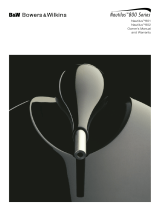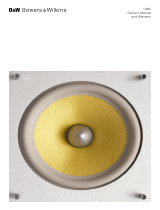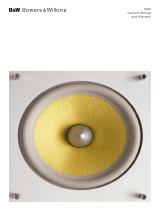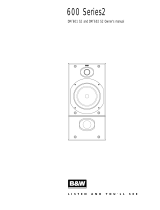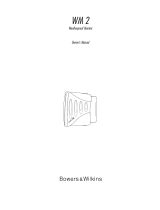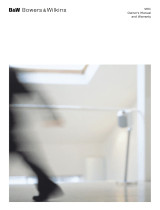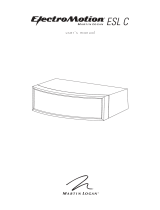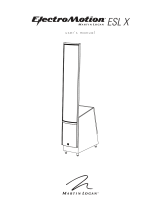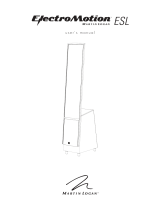English
Limited Warranty
Dear customer,
Welcome to B&W.
This product has been designed and
manufactured to the highest quality
standards. However, if something does go
wrong with this product, B&W
Loudspeakers and its national distributors
warrant free of charge labour (exclusion
may apply) and replacement parts in any
country served by an official B&W
distributor.
This limited warranty is valid for a period of
five years from the date of purchase or two
years for electronics including amplified
loudspeakers.
Terms and Conditions
1 The warranty is limited to the repair of
the equipment. Neither transportation,
nor any other costs, nor any risk for
removal, transportation and installation
of products is covered by this warranty.
2 This warranty is only valid for the
original owner. It is not transferable.
3 This warranty will not be applicable in
cases other than defects in materials
and/or workmanship at the time of
purchase and will not be applicable:
a for damages caused by incorrect
installation, connection or packing,
b for damages caused by any use other
than correct use described in the user
manual, negligence, modifications, or
use of parts that are not made or
authorised by B&W,
c for damages caused by faulty or
unsuitable ancillary equipment,
d for damages caused by accidents,
lightning, water, fire heat, war, public
disturbances or any other cause
beyond the reasonable control of B&W
and its appointed distributors,
e for products whose serial number has
been altered, deleted, removed or
made illegible,
f if repairs or modifications have been
executed by an unauthorised person.
4 This guarantee complements any
national/regional law obligations of
dealers or national distributors and
does not affect your statutory rights as
a customer.
How to claim repairs under
warranty
Should service be required, please follow
the following procedure:
1 If the equipment is being used in the
country of purchase, you should
contact the B&W authorised dealer
from whom the equipment was
purchased.
2 If the equipment is being used outside
the country of purchase, you should
contact B&W national distributor in the
country of residence who will advise
where the equipment can be serviced.
You can call B&W in the UK or visit our
web site to get the contact details of
your local distributor.
To validate your warranty, you will need to
produce this warranty booklet completed
and stamped by your dealer on the date of
purchase. Alternatively, you will need the
original sales invoice or other proof of
ownership and date of purchase.
Owner’s manual
Introduction
Thank you for choosing B&W.
Your Signature series speakers are
precision transducers incorporating many
innovative techniques unique to B&W and
capable of reproducing recorded sound to
the highest standards. So that they may
perform at their best, it is essential to take
time and care with the installation process.
In particular, you must regard the listening
room as an extension of the speaker. The
acoustic character of the room can have a
profound effect on the final sound quality.
Please read this manual fully before
unpacking and installing the product. It will
help you to optimise its performance.
B&W maintains a network of dedicated
distributors in over 60 countries who will be
able to help you should you have any
problems your dealer cannot resolve.
Unpacking (figure 1)
• Fold the carton flaps right back and
invert the carton and contents.
• Lift the carton clear of the contents.
• Remove the polystyrene packing from
the end and sides of the speaker.
• Open the bag and pull it clear of the
base of the speaker.
• Turn the speaker right way up and
remove the final polystyrene tray and
bag.
We suggest you retain the packing for
future use.
Check in the carton for:
• 4 self-adhesive rubber pads.
• 2 terminal link cables
• Cleaning cloth
Wood is a natural material and veneers vary
between batches. Although supplied as
single units, systems with consecutive
serial numbers (odd number lower) have
veneer-matched cabinets. Please be aware
that if more than two speakers are
purchased for a single installation, B&W
cannot guarantee they will all be veneer
matched.
Positioning (figure 2)
Mount the speakers on firm dedicated
stands that place the tweeters
approximately at ear level. Bookshelf
mounting is possible but allows less
opportunity for optimising the sound. The
stand or shelf used can affect the sound
quality of the speaker. Ask your dealer for
advice on the best type for your needs.
4 self-adhesive rubber pads are supplied
which may be fixed to the base of the
speaker to protect the surface and give a
degree of vibration isolation between the
speaker and its support. Alternatively, if you
require more isolation or the support
surface is not quite flat, you may use 4
pieces of malleable re-usable adhesive (for
example Bostik® Blu-Tack®). Some stands
are supplied with upward pointing spikes to
support the speaker and you should be
aware that these will deface the base of the
speaker.
To find the optimum position in the room
may involve a certain amount of
experimentation, but as an initial guide:
• Position the speakers and the centre of
the listening area approximately at the
corners of an equilateral triangle.
• Keep the speakers at least 1.5m apart
to maintain left-right separation.
The proximity of the speakers to walls
affects the sound quality.See the
section“Fine Tuning” below.
Stray magnetic fields
The speaker drive units create stray
magnetic fields that extend beyond the
boundaries of the cabinet.
We recommend you keep magnetically
sensitive articles (television and computer
screens, computer discs, audio and video
tapes, swipe cards and the like) at least
0.5m from the speaker.
Connections (figure 3)
All connections should be made with the
equipment switched off.
Important safety notice:
In certain countries, notably those in
Europe, the use of 4mm banana plugs is
considered a potential safety hazard,
because they may be inserted into the
holes of unshuttered mains supply sockets.
In order to comply with European
CENELEC safety regulations, the 4mm
holes in the ends of the terminals are
blocked by plastic pins. Do not remove the
pins if you are using the product where
these conditions apply.
There are 2 pairs of terminals at the back of
the speaker to permit bi-wiring. The lower
pair feed the bass/midrange drive unit and
the upper pair feed the tweeter.
The terminals are insulated to prevent any
likelihood of electrical shock, even when
the speakers are used with the highest
powered amplifiers, and accept a variety of
cable termination to suit most applications.
Bi-wiring is the preferred method of
connection and involves the use of
separate cables from the amplifier to each
pair of terminals. The separation of the
signal paths improves the resolution of low-
level detail and allows the user to optimise
the type of cable to the frequency range of
use.
1






